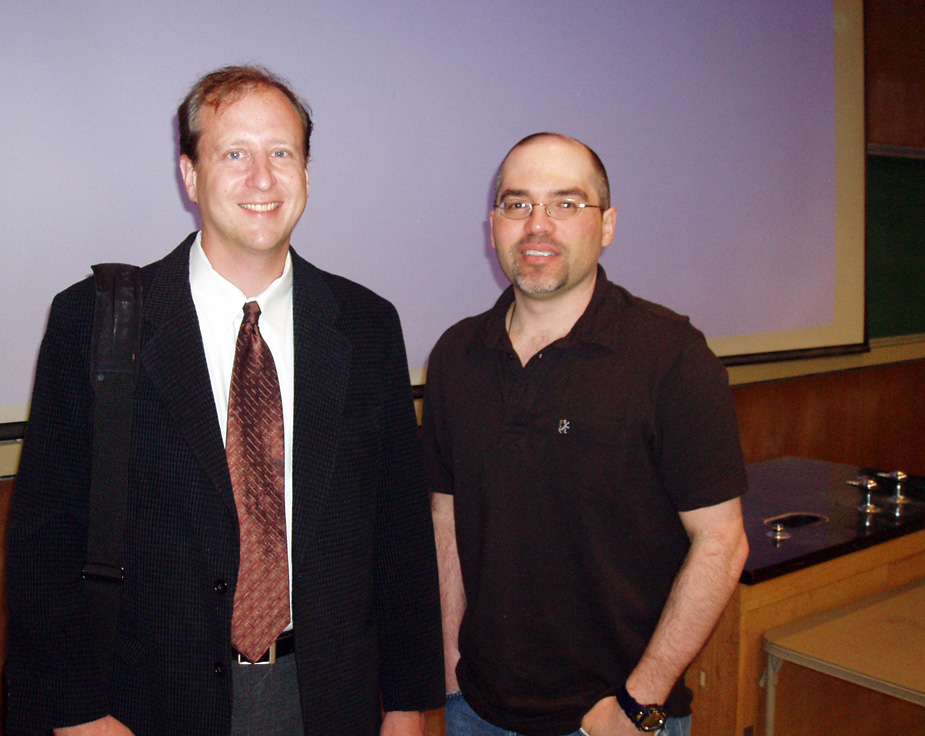
One Class, Two Universities: Internet Video Links Students at UCSB, Jackson State
When Guillermo Bazan asks students in his Organic Semiconductors Structures and Applications class at UC Santa Barbara a question, he usually gets an answer right away. The response, however, might come from someone in a room almost 2,000 miles from Santa Barbara.
Bazan, a professor of materials, and of chemistry and biochemistry, teaches the graduate course in a high-tech classroom on the second floor of the Engineering Science Building at UCSB. More than half a continent away, assistant professor of chemistry Ruomei Gao supervises students taking the same class at Jackson State University in Jackson, Miss. They're all connected via an Internet-based webcast that, thus far, has proved to be very effective.
The class is part of a program called PREM –– Partnership in Research and Education in Materials –– that was created in 2006 thanks to a $2.75 million, five-year grant to UCSB's Materials Research Laboratory and Jackson State University by the National Science Foundation. The PREM program is designed to enhance diversity in materials science through partnerships between minority-serving institutions and NSF-funded material research science and engineering centers. Bazan's class is one of several collaborative projects involving UCSB and Jackson State.
"What is the size and what is the shape of the sensors?" a voice booms over the speakers mounted in the ceiling of the Santa Barbara classroom. The question was asked by one of the Jackson State students, who attend Bazan's class via video images broadcast by wall-mounted cameras in the UCSB classroom. The video is not exactly high-definition, but it's clear enough to see what's being taught. On this particular day, there were 18 students in the Santa Barbara classroom and five in Mississippi.
Without the PREM program, Jackson State students would never get a chance to take this materials class. But, thanks to four video screens, they're able to immerse themselves in Bazan's lectures. One video shows Bazan as he speaks to the class; two others show the UCSB students in the classroom; and the fourth is a big-screen view of his power-point presentations. All videos –– including one of the JSU students in their Mississippi classroom –– are projected on the wall of his classroom. The JSU students use a microphone to ask questions.
It's a new world for Bazan, who has adjusted quickly to the new technology and its impact on his teaching. "I don't think this type of teaching is more difficult than the conventional style," he said. "Our students at UCSB have not felt any impact (from the videoconferencing) and they like the larger community that participates in the class."
While the cyber technology is groundbreaking, it can also be shaky at times. During one class, the video feed disconnected a few minutes before class ended. "It's important to do a couple of trial runs before the first day of classes," Bazan said. "There are sometimes glitches. If these happen, it is important to have someone that knows how to make computers talk to each other. Sometimes we may be delayed a few minutes to make sure all of the technical details are in place."
In Bazan's class, the tech support is provided by Michelle Senatore, a first-year grad student who monitors the video feeds on a master computer in the back of the classroom. She's also enrolled in the class. "It took a little time, maybe two or three classes, to let the students get used to having multiple screens to view, and for the professor to remember to pause and ask JSU students for questions," Senatore said. "But now I think everyone is comfortable with the setup. I'm sure both groups of students benefit from each other's perspectives in this field of research."
So far, the Jackson State students seem to be enjoying the experience. "We actually feel that Dr. Bazan is talking right in this room, not in California," Gao said. "With the support of technology, students can interact directly with the professor. At this point there is not much difference between videoconference and traditional teaching."
But Gao said that some students had initial reservations about the system. "I can see their pressure," she said. "Questions that I was asked many times were ‘How will the professor evaluate us in the final?' and ‘How is he going to calculate final grades?' But they do enjoy the class now. I like the way that Dr. Bazan teaches. This is a very challenging lecture series for our students."
Perhaps more importantly, Gao explains why this particular PREM/NSF collaboration is so valuable for the Jackson State students. "There is no expertise in this area from our department," she said. "It gives our students the opportunity to attend classes taught by the top scientists at the least cost, which will help to enhance their confidence and ability to overcome challenges."
Both instructors see a bright future for videoconference classrooms. "This is definitely the way of the future for many reasons," Bazan said. "It should be possible to coordinate classes whereby experts in different universities contribute to specific topics. The experience with JSU shows that it is possible to coordinate efforts within the U.S., but it also opens the opportunity for international collaborations in education and outreach."
Added Gao: "I definitely hope that our students will have more opportunities to participate in this new teaching-learning process. It is both interesting and exciting."



